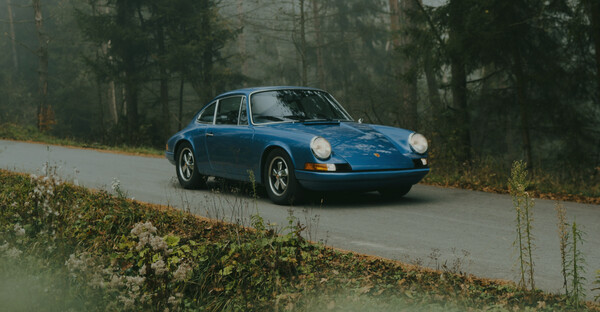Description
Details:
Oldtimer Australia is delighted to offer for sale an extremely rare, factory right hand drive 1973 Jensen SP.
As the saying goes . . . ‘if you know, you know’. This is absolutely the case with the Jensen SP, which was the most powerful, the fastest and one of the rarest and most exclusive cars Jensen ever built.
A copy of the original production card on file confirms this car was ordered on 2nd March 1973. It was ordered with the following options: driver’s door mirror and a Voxson 8-Track player. This UK market car left the factory in the colour scheme of ‘havana’ (brown) with a black vinyl roof and a beige interior.
The warranty claim form on file tells us the car was sold through Jensen distributor Guy Salmon Ltd in Surrey to Mr Bowsher from Aldwick, Bognor Regis in Sussex on 1st May 1973.
The subsequent early history of the car in the UK is not known.
The car found its way to Australia fairly early in its life and it was owned by Professor Roger Leighton from the Sydney University. There is a registration sticker on the front left quarter glass, which confirms that this car was last registered in NSW in 1989.
The current owner acquired the car in the late 1980’s and it joined an extensive and eclectic collection. As with all the cars in his collection, the condition of the car was assessed upon its purchase and a decision was made that it should be repainted and the engine rebuilt. The engine was rebuilt soon after the car was acquired. There is an invoice on file from Ian Harris Engines from Bankstown in NSW dated April 1990.
The paint and body were in ‘fair’ condition so a decision was made to strip the car to bare metal. The necessary body repairs were undertaken before the car was repainted. The owner didn’t like the original colour of ‘havana’ and choose to have the car repainted in the Jensen factory colour of ‘tangerine’. It is understood that this car was repainted some fifteen years ago.
Once the restoration was completed, the car became part of static display. The engine was turned over on a regular basis but the car was never reregistered and driven on the road since the restoration was completed.
At some stage and most likely early in this car’s life the engine block has been replaced. It is running a correct Chrysler 440 V8 engine with three correct twin barrel Holley carburettors (‘Six Pack’).
Today the car presents essentially like a fresh restoration. The stunning ‘tangerine’ paint, which really suits the car, has retained a strong depth of colour and overall it is in excellent condition. There is one small imperfection on the passenger’s door, which has been touched up at some stage. The car has been fitted with an incorrect Jensen badge on the bonnet. It has the standard ‘red’ Jensen badge as used on the Interceptor. It should have a ‘blue’ Jensen badge, which was used for the FF and the SP. The black vinyl roof is in very good condition and it has probably never seen the harsh Australian sun. The external trim is in good condition, though the chrome is just starting to show some light wear.
The original Jensen wheels which are a real feature, are in good condition. They are currently shod with Yokohama tyres size 215/ 60 VR15. These tyres are old and should be replaced before the car is driven on the road.
Open the door and you are welcomed by a very good looking interior. The beige colour of the upholstery contrasts the exterior colour perfectly and gives the car a very elegant and ‘oh so seventies’ appearance. The interior, which has been refreshed at some stage, presents well. The seats are in good condition with no rips or tears. They also provide ample support. The instruments are all clear and in good condition. The one thing we noticed is that the red lens is missing for the handbrake, brake pad wear and fluid level warning light on the right side of the steering wheel. The dashboard is in very good condition and due to the fact the car has been in storage for many years, like the vinyl roof, it has not been affected by the sun. The steering wheel is very elegant and looks almost too delicate for a British muscle car! It is in very good condition. New carpets were fitted when the car was restored and they are still in very good condition.
In the engine bay everything is clean and appears to be correct. The car is fitted with factory air conditioning.
This Jensen SP has not been driven for some 15 years and as a result it will require recommissioning. Prior to the car arriving in our showroom the owner did crank over the engine and it turns over easily. This has been recorded on a video, which we have on file.
We envisage that the recommissioning process will be relatively straight forward. We are happy to discuss our thoughts with any prospective purchaser.
Accompanying the car is a spare wheel, a reprint of a Jensen Interceptor III owner’s manual and some invoices showing the work done to the car.
Jensen SP’s do not come onto the world market very often and an SP is indeed a very rare car in Australia. Here is a unique opportunity to acquire one of only 219 factory right hand drive Jensen SP’s ever built.
Highlights:
- Rare, factory right hand drive example, being one of only 219 produced.
- A rare car in Australia.
- STUNNING colour scheme.
- Beautifully presented.
Price AUD $169, 950
Background:
Like many British sporting car manufacturers, the Jensen story is an interesting one. Brothers Alan and Richard Jensen were ‘car guys’ and in the 1920’s and 1930’s they were heavily involved in coachbuilding, both as a hobby and profession. In 1931 the Jensen brothers went to work for coachbuilder WJ Smith & Sons in West Bromwich, building bodies for sports cars, which was ultimately the birth of Jensen Motors. In 1934 Smith died and the Jensen brothers took a controlling interest in the business, which was renamed as Jensen Motors Limited.
Jensen Motors built customised bodies for manufacturers including Morris, Singer, Standard, Wolseley and even Ford. The work with Ford evolved into Jensen’s first production car, the S-Type, built from 1935 through until 1941. Jensen diversified into building commercial vehicles in the late 1930’s and this business thrived during the second World War.
In 1946 Jensen restarted building cars, however, production of its new model the PW (only 20 examples built from 1946 – 1952) and later the Interceptor (only 88 examples built from 1950 – 1957) was very sporadic. Jensen introduced the 541 at the London Motor Show in October 1953. Today the Jensen 541 is recognised as Jensen’s first ‘real production car’. Built on a steel chassis with a fibreglass body and aluminium doors, the 541 was powered by a 4. 0 litre 6 cylinder engine. The model evolved to the 541 Deluxe, 541R and 541S. In total Jensen built 546 of all 541 variants.
In 1962 Jensen wedged a Chrysler V8 under the bonnet and with other improvements the Jensen C-V8 was born. The Jensen C-V8 was successful with circa 500 examples built from 1962 – 1966 and back then it was one of the fastest 4 seater GT cars in the world.
The C-V8 really put Jensen on the world map and they turned to Carrozzeria Touring in Italy to design its new model, the Interceptor. Jensen opted for a traditional steel body but continued the relationship with Chrysler and the new Interceptor was powered by a 383 cubic inch V8 engine. The car was to be built in Italy by Vignale, however, that relationship was short lived and Jensen soon took production back in house to their West Bromwich factory. The Jensen Interceptor went on to become one of the most recognisable and most successful sporting cars ever built.
In total circa 6, 700 Jensen Interceptors were built over 10 years of production between 1966 and 1976.
The Interceptor evolved from the original Vignale bodied Mark I (estimated 60 right hand drive and 32 left hand drive cars built) to the Jensen built Mark I (932 cars built), the Mark II (1, 128 cars built) – which was introduced in late 1969 to comply with US safety & emission requirements and the Mark III (3, 743 cars built) – introduced in 1971 which had different engine options.
Jensen also offered the Interceptor as a four wheel drive and this model, known as the FF, was ‘years ahead of its time’ and a fabulous offering for the company. Jensen also offered the Interceptor as a convertible targeting the lucrative American market. In addition to the production numbers above, Jensen built 327 FF’s from 1967 – 1971 and 512 Convertibles from 1973 – 1976.
The pinnacle of the Interceptor range was the Jensen SP that was introduced in 1971.
When Jensen started to phase out the FF model they were in desperate need of a flagship model to fill the gap until they could introduce the all new Jensen ‘F’ Type, which they were hoping would go into production in 1973. After lengthy discussions in the boardroom, it was decided to introduce a high performance version of the Interceptor would fit the bill. Chrysler was contacted to see if they could provide a suitable engine again. They had a small batch of ‘Six-Pack’ performance engines which they could no longer use for the American market due to the new emission regulations.
To many, the SP is what the Interceptor should have been from the moment it was introduced. The engine in the SP produces a whopping 385HP compared to the 325HP in standard Interceptor, making it the most powerful and the fastest car Jensen had ever built.
To make the model stand out from the standard Interceptor a vinyl covered roof was now standard. The car also had a fully louvered bonnet, a blue SP badge (there was no Interceptor badge on the car at all) and a high value 8-Track system was installed rather than a standard radio.
In total 232 Jensen SP’s were produced, of which 219 were right hand drive and 13 were left hand drive.
















